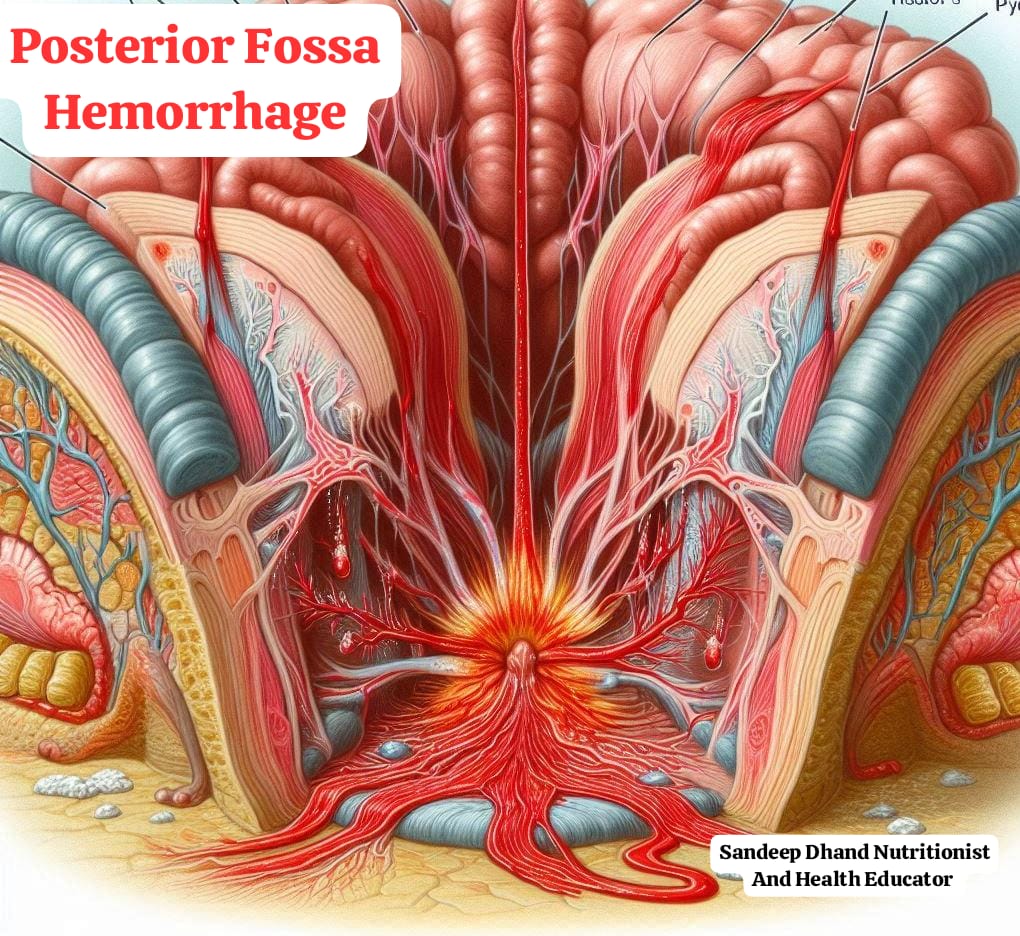Sandeep Dhand
Nutritionist And Health Educator
Introduction
Posterior fossa hemorrhage refers to bleeding in the posterior fossa, a small space in the back of the skull. This area contains critical parts of the brain, including the cerebellum and brainstem, which control essential functions like balance, coordination, and basic life-sustaining processes.

Due to its confined space, even a small amount of bleeding can create severe complications, making it a medical emergency. In this article, we will delve into the causes, symptoms, diagnostic methods, treatments, and prevention strategies for posterior fossa hemorrhage.
Causes of Posterior Fossa Hemorrhage

Several factors can lead to bleeding in the posterior fossa:

- High Blood Pressure:
Chronic hypertension weakens blood vessel walls, leading to rupture. - Trauma:
A blow to the back of the head can cause bleeding in this region. - Aneurysms or AVMs:
Weak blood vessels or abnormal connections can burst, leading to hemorrhage. - Tumors:
Brain tumors in the posterior fossa can erode blood vessels. - Blood-Clotting Disorders:
Conditions like hemophilia or overuse of anticoagulants can increase the risk of bleeding. - Infections:
In rare cases, infections can weaken blood vessels in this area.
Symptoms of Posterior Fossa Hemorrhage

Symptoms often appear suddenly and may worsen quickly due to the restricted space in the posterior fossa. Common signs include:
- Severe Headache:
Often felt in the back of the head. - Vomiting and Nausea:
Caused by pressure on the brainstem. - Loss of Balance and Coordination:
Difficulty walking or standing due to cerebellum involvement. - Vision Changes:
Double vision or difficulty focusing. - Dizziness:
A spinning sensation, often accompanied by balance issues. - Altered Consciousness:
Drowsiness, confusion, or even coma in severe cases.
Diagnosis of Posterior Fossa Hemorrhage
Diagnosing this condition involves advanced imaging and tests:
- CT Scan:
This is the fastest way to detect bleeding in the posterior fossa. - MRI:
Provides more detailed images, especially for smaller hemorrhages. - Angiography:
Used to identify underlying vascular abnormalities like aneurysms. - Neurological Examination:
Assesses balance, reflexes, and coordination to pinpoint affected areas.
Treatment of Posterior Fossa Hemorrhage
Immediate treatment is crucial due to the life-threatening nature of this condition. Common treatments include:
- Medications:
Drugs to lower blood pressure.
Diuretics to reduce brain swelling.
Medications to prevent seizures.
- Surgical Intervention:
Craniotomy: Removing part of the skull to relieve pressure and drain blood.
Ventriculostomy: A procedure to drain cerebrospinal fluid and reduce pressure.
- Intensive Care Monitoring:
Continuous monitoring of vital signs and brain activity is essential. - Rehabilitation:
Physical therapy, speech therapy, and occupational therapy may be needed for recovery.
Prevention of Posterior Fossa Hemorrhage
Preventive strategies are similar to those for other brain hemorrhages:
- Control Hypertension:
Regularly monitor and manage high blood pressure. - Protect the Head:
Use helmets during risky activities and ensure safety measures are in place. - Avoid Smoking and Alcohol:
These can damage blood vessels over time. - Treat Underlying Conditions:
Address any vascular abnormalities or clotting disorders. - Healthy Lifestyle:
Eat a balanced diet, exercise regularly, and maintain a healthy weight.
Conclusion
Posterior fossa hemorrhage is a rare but dangerous condition that requires immediate medical attention. Early diagnosis and treatment are critical to preventing long-term complications or death. By understanding the causes, recognizing the symptoms, and adopting preventive measures, individuals can reduce their risk and maintain better brain health.
